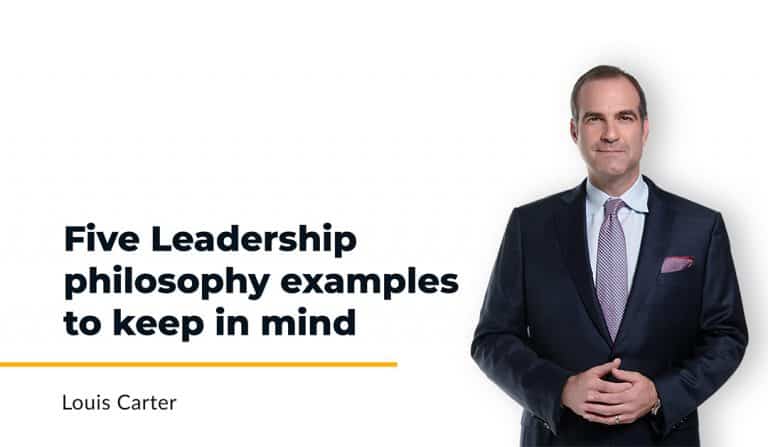
5 Most Valuable Leadership Philosophy Examples to Understand
Use our tools, guides, and processes to develop, assess, and become even more successful in living your leadership philosophy. We have helped over 42,000 accomplished
To succeed in leadership or management, you will need to develop a solid understanding of styles of leadership that are common in many organizations today.









Published on February 1st
An autocratic leader makes decisions without input from others. They generally don’t take advice from subordinates and expect them to conform to their choices. Autocratic leadership is in stark contrast to the democratic leadership style, which values participation from most stakeholders and constituents. An autocratic leader can be effective when they earn and sustain the understanding, trust, and respect of their followers. Autocratic leaders can get the work done best by combining it with task-oriented, facilitative, charismatic, and transactional leadership to help manage decisions and get the job done.

Published on February 8th
People with the charismatic leadership style can be invaluable to a company looking to grow or when facing a business crisis. This is because they can quickly turn things in their favor by developing a deep understanding of the people around them. This type of leader can be especially effective when matching transactional leadership styles because followers are more likely to follow charismatic leaders who can show empathy and achieve high trust levels. Charismatic leadership can also be highly dysfunctional when not paired with task-oriented leadership, because oftentimes there are challenges with follow-through.

Published on February 15th
Laissez-faire leadership grants complete freedom to subordinates or followers to function how they want and with what they want; a laissez-faire leader leaves followers with as many roles and choices as possible. This leadership style also uses the delegative leadership style, which involves delegating work to competent, trustworthy, and known to execute flawlessly. Delegation comes with challenges, especially when it comes to project management. It is strongly advisable to follow-up and inspect what you expect when it comes to this open leadership style.

Published on February 22nd
Participative leadership can often be a sluggish form of decision-making. It has its place when leading large system transformation. It has many benefits that can make it the best type of leadership in specific organizations or environments that foster more open and collaborative decision-making with individual contributors with specialized business expertise.

Published on March 1st
Servant leaders share authority and decision-making power with those under them. They lead the company based on the team’s interests. Servant leadership and transactional leadership is often be combined to get the work done. People often misunderstand this leadership style and attribute it to being passive — however servant leadership is all about serving the system and people within it to achieve its highest and greatest good.

Published on March 8th
The Directive Leader can provide guidance, create goals, and establish timelines and criteria for business success. However, if the situation warrants, a directive leader can adapt and display supportive conduct as well. Directive leadership is excellent for combining management with leadership because it allows the leader to get closer to the work, and provide input that may be critical to the success of a project.

Published on March 15th
Facilitative and transactional leaders are complementary leadership styles. A facilitative leader facilitates the execution of work to make things easier for subordinates. A variety of exercises help the team reach a consensus and encourage commitment to collective decisions. Facilitative leaders see the big picture, while transactional leaders focus on values achievement and execution and get the job done together.

Published on March 22nd
This style often encourages trust and transparency amongst team members. This leadership style can be very effective in organizations with a creative workforce that excels in interactive environments. This style of leadership is in contrast to transactional leadership. Transactional leadership is focused on structure, process and execution whereas transformational leadership focuses on a more visionary, relationship-oriented decision making process that promotes collaborative decision making.

Published on March 29th
Task-oriented leaders have many attributes that help ensure that things carry out in a professional and timely way. Typically, these leaders develop simple, easy-to-follow work plans with specific timelines and requirements to confirm this. Transactional and task-oriented leadership complement each other because both styles can provide structure and direction – and reduce time to completion metrics.
Democratic leadership is a leadership style used primarily for government, school systems, non-profit organizations, or other social systems that require majority ownership over decision-making. This type of leadership is sometimes slow and bureaucratic because it requires the input of a majority of constituents before making a final business decision. Democratic leaders must lead within the boundaries of their different decision-making structures and checks and balances.
Transactional leaders typically run large operational enterprises that require fast decisions. This type of leadership typically requires a shorter rapid decision-making time; thus, direct orders are necessary. Large military organizations with a transparent chain of command make decisions rapidly often use the transactional leadership approach.

Use our tools, guides, and processes to develop, assess, and become even more successful in living your leadership philosophy. We have helped over 42,000 accomplished

In this article, I describe the leadership styles of Robert F. Kennedy, Jr. that helped calm rather than incite riots after the assassination of Martin Luther King, Jr. that we can learn and apply to our current day conflicts.

This article will bring you through 8 steps toward creating and sustaining your leadership legacy. It includes thought statements, examples, and cases to help you

Inspiration is all around us if we look close enough. Inspiration comes in many forms – from first responders to the people who help us

“We’ve had three big ideas at Amazon that we’ve stuck with for 18 years, and they’re the reason we’re successful: Put the customer first. Invent.

We all succeed on the backs of others. They teach, model, and lead. Their words and work help us navigate what we didn’t expect, value what works for us, and draw a personal career path.
I invite you to speak with my team about working with us in our executive coaching, or leadership training and development program!
Join other 42.000 accomplished leaders who have become more effective and successful as a result of our programs.
